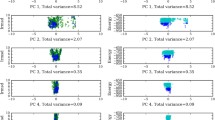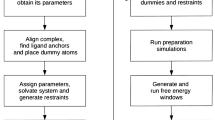Abstract
We present a new algorithm for unbound (real life) docking of molecules, whether protein-protein or protein-drug. The algorithm carries out rigid docking, with surface variability/flexibility implicitly addressed through liberal intermolecular penetration. The high efficiency of the algorithm is the outcome of several factors: (i) focusing initial molecular surface fitting on localized, curvature based surface patches; (ii) use of Geometric Hashing and Pose Clustering for initial transformation detection; (iii) accurate computation of shape complementarity utilizing the Distance Transform; (iv) efficient steric clash detection and geometric fit scoring based on a multi-resolution shape representation; and (v) utilization of biological information by focusing on hot spot rich surface patches. The algorithm has been implemented and applied to a large number of cases.
To whom correspondence should be addressed
The publisher or recipient acknowledges right of the U.S. Government to retain a nonexclusive, royalty-free license in and to any copyright covering the article.
Access this chapter
Tax calculation will be finalised at checkout
Purchases are for personal use only
Preview
Unable to display preview. Download preview PDF.
Similar content being viewed by others
References
C. Branden and J. Tooze. Introduction to Protein Structure. Garland Publishing, Inc., New York and London, 1991.
J.C. Camacho, D.W. Gatchell, S.R. Kimura, and S. Vajda. Scoring docked conformations generated by rigid body protein-protein docking. PROTEINS: Structure, Function and Genetics, 40:525–537, 2000.
R. Chen and Z Weng. Docking unbound proteins using shape complementarity, desolvation, and electrostatics. PROTEINS: Structure, Function and Genetics, 47:281–294, 2002.
M.L. Connolly. Analytical molecular surface calculation. J. Appl. Cryst., 16:548–558, 1983.
M.L. Connolly. Solvent-accessible surfaces of proteins and nucleic acids. Science, 221:709–713, 1983.
M.L. Connolly. Shape complementarity at the hemoglobin αβ1 subunit interface. Biopolymers, 25:1229–1247, 1986.
T. H. Cormen, C. E. Leiserson, and R. L. Rivest. Introduction to Algorithms, chapter 26. The MIT Press, 1990.
M. de Berg, M. van Kreveld, M. Overmars, and O. Schwarzkopf. Computational Geometry: Algorithms and Applications. Springer-Verlag, 2000.
T.J.A. Ewing, Makino S., Skillman A.G., and I.D. Kuntz. Dock 4.0: Search strategies for automated molecular docking of flexible molecule databases. J. Computer-Aided Molecular Design, 15:411–428, 2001.
D. Fischer, S. L. Lin, H.J. Wolfson, and R. Nussinov. A geometry-based suite of molecular docking processes. J. Mol. Biol., 248:459–477, 1995.
H.A. Gabb, R.M. Jackson, and J.E. Sternberg. Modelling protein docking using shape complementarity, electrostatics, and biochemical information. J. Mol. Biol., 272:106–120, 1997.
E.J. Gardiner, P. Willett, and P.J. Artymiuk. Protein docking using a genetic algorithm. PROTEINS: Structure, Function and Genetics, 44:44–56, 2001.
B.B. Goldman and W.T. Wipke. Molecular docking using quadratic shape descriptors (qsdock). PROTEINS: Structure, Function and Genetics, 38:79–94, 2000.
I. Halperin, B. Ma, H. Wolfson, and R. Nussinov. Principles of docking: An overview of search algorithms and a guide to scoring functions. PROTEINS: Structure, Function and Genetics, 47:409–443, 2002.
Z. Hu, B. Ma, H.J Wolfson, and R. Nussinov. Conservation of polar residues as hot spots at protein-protein interfaces. PROTEINS: Structure, Function and Genetics, 39:331–342, 2000.
R.M. Jackson. Comparison of protein-protein interactions in serine protease-inhibitor and antibody-antigen complexes: Implications for the protein docking problem. Protein Science, 8:603–613, 1999.
F. Jiang and S.H. Kim. Soft docking: Matching of molecular surface cubes. J. Mol. Biol., 219:79–102, 1991.
G. Jones, P. Willet, R. Glen, and Leach. A.R. Development and validation of a genetic algorithm for flexible docking. J. Mol. Biol., 267:727–748, 1997.
E. Katchalski-Katzir, I. Shariv, M. Eisenstein, A.A. Friesem, C. Aflalo, and I.A. Vakser. Molecular Surface Recognition: Determination of Geometric Fit between Protein and their Ligands by Correlation Techniques. Proc. Natl. Acad. Sci. USA, 89:2195–2199, 1992.
I.D. Kuntz, J.M. Blaney, S.J. Oatley, R. Langridge, and T.E. Ferrin. A geometric approach to macromolecule-ligand interactions. J. Mol. Biol., 161:269–288, 1982.
H.P. Lenhof. Parallel protein puzzle: A new suite of protein docking tools. In Proc. of the First Annual International Conference on Computational Molecular Biology RECOMB 97, pages 182–191, 1997.
S. L. Lin, R. Nussinov, D. Fischer, and H.J. Wolfson. Molecular surface representation by sparse critical points. PROTEINS: Structure, Function and Genetics, 18:94–101, 1994.
R. Norel, S. L. Lin, H.J. Wolfson, and R. Nussinov. Shape complementarity at protein-protein interfaces. Biopolymers, 34:933–940, 1994.
R. Norel, S. L. Lin, H.J. Wolfson, and R. Nussinov. Molecular surface complementarity at protein-protein interfaces: The critical role played by surface normals at well placed, sparse points in docking. J. Mol. Biol., 252:263–273, 1995.
R. Norel, D. Petrey, H.J. Wolfson, and R. Nussinov. Examination of shape complementarity in docking of unbound proteins. PROTEINS: Structure, Function and Genetics, 35:403–419, 1999.
P.N. Palma, L. Krippahl, J.E. Wampler, and J.G Moura. Bigger: A new (soft)docking algorithm for predicting protein interactions. PROTEINS: Structure, Function and Genetics, 39:372–384, 2000.
M. Rarey, B. Kramer, and Lengauer T. Time-efficient docking of flexible ligands into active sites of proteins. In 3’rd Int. Conf. on Intelligent Systems for Molecular Biology (ISMB’95), pages 300–308, Cambridge, UK, 1995. AAAI Press.
B. Sandak, H.J. Wolfson, and R. Nussinov. Flexible docking allowing induced fit in proteins. PROTEINS: Structure, Function and Genetics, 32:159–174, 1998.
G. Stockman. Object recognition and localization via pose clustering. J. of Computer Vision, Graphics, and Image Processing, 40(3):361–387, 1987.
I.A. Vakser. Protein docking for low resolution structures. Protein Engineering, 8:371–377, 1995.
I.A. Vakser. Main chain complementarity in protein recognition. Protein Engineering, 9:741–744, 1996.
I.A. Vakser, O.G. Matar, and C.F. Lam. A systematic study of low resolution recognition in protein-protein complexes. Proc. Natl. Acad. Sci. USA, 96:8477–8482, 1999.
P.H. Walls and J.E. Sternberg. New algorithms to model protein-protein recognition based on surface complementarity; applications to antibody-antigen docking. J. Mol. Biol., 228:227–297, 1992.
H.J. Wolfson and I. Rigoutsos. Geometric hashing: An overview. IEEE Computational Science and Eng., 11:263–278, 1997.
Author information
Authors and Affiliations
Editor information
Editors and Affiliations
Rights and permissions
Copyright information
© 2002 Springer-Verlag Berlin Heidelberg
About this paper
Cite this paper
Duhovny, D., Nussinov, R., Wolfson, H.J. (2002). Efficient Unbound Docking of Rigid Molecules. In: Guigó, R., Gusfield, D. (eds) Algorithms in Bioinformatics. WABI 2002. Lecture Notes in Computer Science, vol 2452. Springer, Berlin, Heidelberg. https://doi.org/10.1007/3-540-45784-4_14
Download citation
DOI: https://doi.org/10.1007/3-540-45784-4_14
Published:
Publisher Name: Springer, Berlin, Heidelberg
Print ISBN: 978-3-540-44211-0
Online ISBN: 978-3-540-45784-8
eBook Packages: Springer Book Archive




